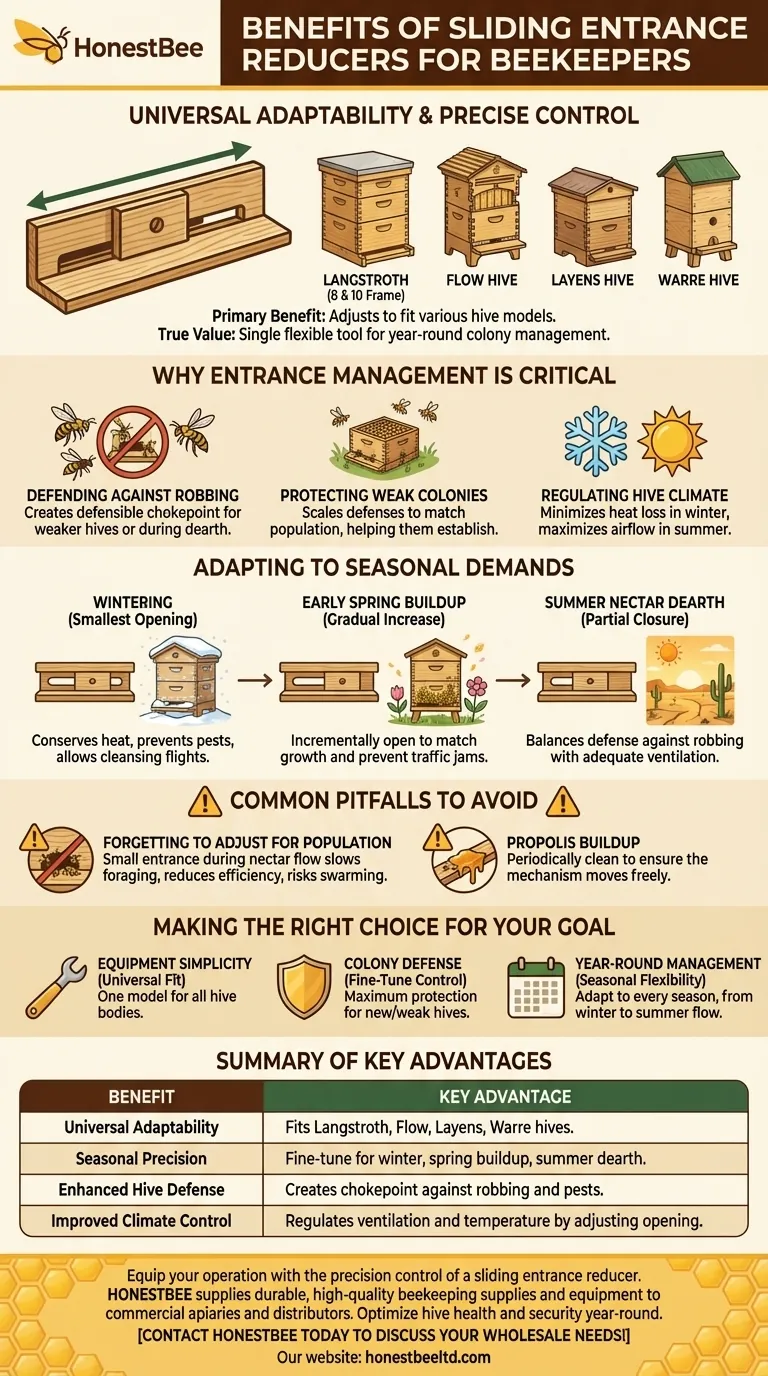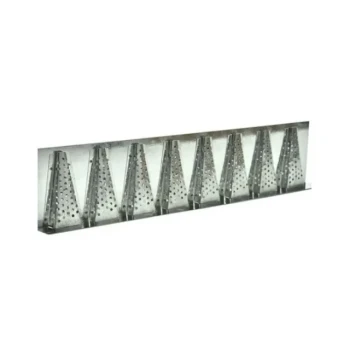The primary benefit of a sliding entrance reducer is its universal adaptability. This design allows a single reducer to adjust its length to fit a wide variety of hive types, from standard 8-frame and 10-frame Langstroth hives to alternative models like Flow, Layens, and Warre hives.
The true value of a sliding entrance reducer isn't just fitting different boxes, but providing a single, flexible tool to manage the changing defensive and environmental needs of a colony throughout the entire year.

Why Entrance Management is Critical
An entrance reducer is a fundamental tool for proactive hive management. Controlling the size of the main entrance gives the beekeeper significant influence over the colony's security, climate control, and overall health.
Defending Against Robbing
A large, undefended entrance is an open invitation for robber bees from stronger colonies or other insects like wasps.
A smaller entrance creates a defensible chokepoint. The colony's guard bees can more easily repel intruders, which is crucial for weaker hives or during a nectar dearth when robbing pressure is high.
Protecting Weak or New Colonies
Small colonies, newly installed packages, or nucleus hives have fewer bees available for guard duty.
By reducing the entrance size, you are effectively scaling the hive's defenses to match the colony's population, giving them a fighting chance to establish themselves.
Regulating Hive Climate
The entrance is a key factor in the hive's ventilation and temperature regulation system.
In winter, a small opening minimizes heat loss and prevents pests like mice from entering. In the peak of summer, a larger opening is necessary to maximize airflow and help the bees cool the hive.
How the Sliding Design Adapts to Seasonal Demands
The key advantage of the sliding mechanism is the fine-tuned control it offers. Instead of being limited to a few pre-set notches on a wooden block, a sliding reducer allows for precise adjustments as conditions change.
Wintering Configuration
During winter, the colony is at its smallest and most vulnerable. The entrance should be reduced to its smallest possible opening.
This conserves critical heat and provides a minimal, easily guarded space that keeps rodents out while still allowing for cleansing flights on warmer days.
Early Spring Buildup
As the queen begins laying and the population grows, the entrance can be gradually opened.
The sliding design allows you to incrementally increase the opening to match the colony's growth, preventing traffic jams as more foragers begin to fly.
Summer Nectar Dearth
During hot periods when nectar is scarce, robbing becomes a major threat. A sliding reducer can be partially closed.
This strikes a crucial balance: keeping the entrance defensible against robbers while still allowing for adequate ventilation in the summer heat.
Common Pitfalls to Avoid
While highly effective, an adjustable reducer requires active management. Setting it and forgetting it can cause problems for the colony.
Forgetting to Adjust for Population
As a colony explodes in population during a nectar flow, a small entrance can create a "traffic jam."
This slows down foraging, reduces efficiency, and can even contribute to swarming impulses. You must remember to open the entrance as the colony strengthens.
Propolis Buildup
Bees use a sticky resin called propolis to seal cracks in the hive.
Over time, this can gum up the sliding mechanism, making it difficult to adjust. It's important to periodically clean the reducer to ensure it moves freely when you need it to.
Making the Right Choice for Your Goal
An adjustable entrance reducer empowers you to respond precisely to your colony's needs.
- If your primary focus is equipment simplicity: A sliding reducer's universal fit means you only need one model for all your different hive bodies.
- If your primary focus is colony defense: The ability to fine-tune the entrance size gives you maximum control to protect new or weak hives from robbing.
- If your primary focus is year-round management: The sliding design provides the flexibility to adapt to every season, from the tightest winter cluster to the busiest summer nectar flow.
Ultimately, a sliding entrance reducer is a simple piece of equipment that provides a sophisticated level of control over the health and security of your hive.
Summary Table:
| Benefit | Key Advantage |
|---|---|
| Universal Adaptability | Fits 8-frame, 10-frame Langstroth, Flow, Layens, and Warre hives. |
| Seasonal Precision | Fine-tune entrance size for wintering, spring buildup, and summer dearth. |
| Enhanced Hive Defense | Creates a defensible chokepoint to protect against robbing and pests. |
| Improved Climate Control | Regulates ventilation and temperature by adjusting the opening size. |
Equip your operation with the precision control of a sliding entrance reducer. HONESTBEE supplies durable, high-quality beekeeping supplies and equipment to commercial apiaries and beekeeping equipment distributors through our wholesale-focused operations. Let us help you optimize hive health and security year-round. Contact HONESTBEE today to discuss your wholesale needs!
Visual Guide

Related Products
- Multi-Functional Sliding Hive Entrance for Beekeeping
- Beehive Entrance Reducer Guardian Metal Hive Entrance for Bees
- Multi-Functional Rotary Hive Entrance Disc for Beekeeping
- Steel Round Disc Entrance Reducer for Flexzion Bee Hive Nuc Box Gate
- Beehive Entrance Discs Plastic Bee Entrance Disc for Bee Hives
People Also Ask
- How can a Langstroth hive entrance be adjusted? Mimic Natural Bee Preferences for a Healthier Hive
- How do bees manage debris with a small hive entrance? A Guide to Strategic Hive Management
- What size is the entrance hole in a native bee hive? The 13mm Standard for a Thriving Colony
- What is the purpose of placing an object in front of the hive entrance after a move? A Guide to Forced Reorientation
- What are the different entrance sizes for an 8 or 10-frame Langstroth hive? A Guide to Seasonal Management



















